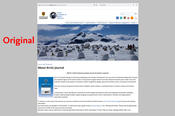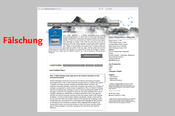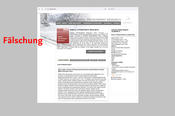Watch Out! Fake!
Focus on “Good Research Practice”: Economist Anna Abalkina at the Institute for East European Studies at Freie Universität Berlin investigates illegal activities in the publishing industry
May 02, 2022
Fake journals harm science and scholarship. Anna Abalkina, an economist at the Institute for East European Studies at Freie Universität, investigated the phenomenon of hijacked journals.
Image Credit: Bernd Wannenmacher
Counterfeit designer bags, perfumes, and medicines – that is nothing new. But fake science journals? Yes, they exist, and they are a problem. Anna Abalkina, who has a doctorate in economics, is researching the methods of hijacked journals at the East European Institute of Freie Universität Berlin. The operators of hijacked journals forge websites of serious publications and collect fees from unsuspecting scholars and scientists to publish their articles.
Abalkina specializes in corruption in the academic world in Russia. Since 2013 she has also been an honorary expert for the Dissernet network, which – like Vroniplag in Germany – looks for plagiarism in doctoral theses. As part of this work, she came across “hijacked journals” and decided to investigate the phenomenon further. In an interview with campus.leben, she explains how this fraud works and what damage it does to science and scholarship.
Dr. Abalkina, what exactly are “hijacked journals”?
Hijacked journals imitate the name and often the ISSN number (a standard number that uniquely identifies journals and series) of reputable academic journals. The people behind it run one or more fake websites and offer scholars and scientists an opportunity to, for a fee, quickly publish their research results online. There are of course no peer reviews, i.e., the appraisal by specialist colleagues according to the criteria of good research practice.
Hijacked journals deceive authors into believing that they are submitting their manuscripts to a genuine, credible journal. Clearly, the operators of these journals are committing fraud and violating intellectual property rights, offenses that can be prosecuted in many countries.
There is also an even larger group of so-called predatory journals, which have some things in common with hijacked journals. Predatory journals also often promise good peer reviews, guarantee publication, and charge high fees in return. They make false statements about their impact factor and editor boards, which also violates the rules of good research practice. But they do not masquerade as something else like hijacked journals do. That is a fundamental difference.
How does this misuse harm science and scholarship?
Just like predatory journals, hijacked journals also have their articles listed in scientific databases such as Scopus and Web of Science and their websites displayed on portals such as Scimago. Scopus, for example, is one of the largest abstract and citation databases for peer-reviewed literature. These types of databases enable us to get an overview of research results from all over the world. They also calculate the scientific and scholarly reputation of journals and researchers. Researchers import data from these databases every day for their own work and consider them to be reliable.
The scammers manage to smuggle in their illegal content into these databases. It is a bit like selling counterfeit drugs at the pharmacy. For example, on the World Health Organization website I found a library of publications about Covid-19, apparently based on a list from Scopus. The list contains around 400 publications from hijacked journals.
If the operators of Scopus discover illegal content in their database, they withdraw it, but the process is not transparent. Scopus does not notify its users that a particular journal has been “hijacked.” So the scammers carry on.
How long have hijacked journals been in existence, and how common are they?
The first cases appeared about ten years ago. There are now more than 200 documented cases, but it is safe to assume that the number of unreported cases is higher. There are unofficial lists such as the Beall’s List, but they are not systematically updated. Some of the documented titles are still active.
Some researchers may be tempted to publish quickly in a fake journal without a peer-review process. After all, almost everywhere in the world, publications indexed in Scopus or other citation databases are a prerequisite for receiving research grants, promotions, or degrees. It is important to warn researchers against this temptation: Articles in hijacked journals are considered unpublished. The domains of these websites often expire again after a short time. In that case, everything is lost – the money and the publication.
Are certain disciplines more affected than others?
No, because the hijacker clones’ strategy is to publish as many articles as possible in a short period of time. It does not seem to matter to them which disciplines the articles come from, as long as the fee is paid. For example, I was contacted by a psychologist who discovered that he had been quoted in a publication in a journal called Waffen- und Costumekunde (roughly translated: Weapons and Costume Studies). We came to the conclusion that the journal was hijacked.
It is more interesting to consider what kinds of journals are being copied. Here there is actually a trend in that the ones most likely to be affected are small, highly specialized journals from developed countries that are hardly known to the public. These titles often only appear in print, meaning that only the fake website can be found online. It appears that the internet pirates clone trade journals with no internet homepage or ones with an expired internet domain and then register the webpage for themselves. Or they falsify journals that have been discontinued or have changed the title and ISSN and pretend to continue. They use spam emails to “court” potential authors whose email addresses they have extracted from reputable or predatory publishers or bought from bogus conference organizers. Through search engine optimization, they ensure that their fake pages are displayed at the top of hit lists.
How can researchers recognize if a journal is genuine?
That is not always easy. One researcher told me that she wrote to Scopus four times to ask if a particular journal was authentic. Scopus confirmed four times that it was a legitimate journal, but it was not. Another researcher told me that he is a researcher and not an investigator.
However, there are indications: Does the title of the journal match the articles that are published there? Can you find authentic information about members of the Board of Editors by searching Google? Many fake journals put fictitious names on the internet. In addition, scammers are always anonymous.
If you check the website whois.domaintools.com see that a journal was registered a few months ago to a John Doe in Arizona and the email address is through gmail or yahoo, it is a pretty good indication that it is fraudulent. If the publishers promise to publish your article within two or three days, it pays to be cautious. The ISSN code of the journal can be checked on the ISSN portal https://portal.issn.org/. Other suspicious signs are many misspellings on the website, bloated impact factors, and simple submission formats.
What other topics are you currently researching?
One of my projects is about corruption in research in Russia. I am analyzing a new law that requires researchers in academic institutions to publish more. I found out that many scholars and scientists do not write the required articles themselves, but buy coauthorship from so-called “paper mills,” i.e., profit-oriented and possibly illegal organizations that produce and sell fraudulent manuscripts. I discovered more than 300 articles by Russian scholars and scientists coming out of such paper mills. I have already published the study on the preprint server arxiv.
Marion Kuka conducted the interview. It was originally published in German on March 4, 2022, in campus.leben, the online magazine of Freie Universität Berlin.
Further Information
- Article and conversation with Anna Abalkina in the Journal Laborjournal (in German): Auf Kaperfahrt im Internet: Hijacked Science Journals, October 12, 2021
- Post in Clariavate blog, operated by the Web of Sience citation database: Hijacked journals: what they are and how to avoid them, January 14, 2019





